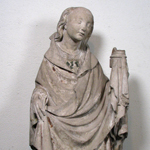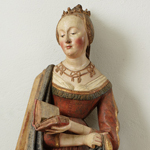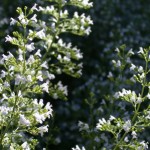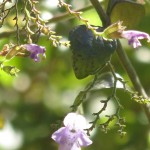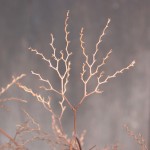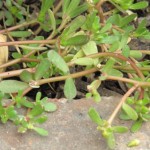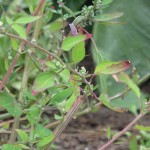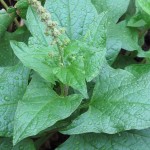Archive for the ‘Food and Beverage Plants’ Category
Friday, November 25, 2011
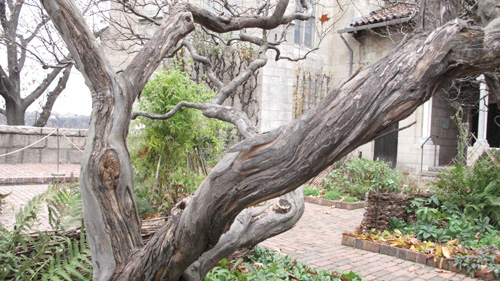
Now that this??veteran quince has regained vigor and the branches have grown thicker, the bark is splitting under the pressure of the increased diameter. The plates formed by the??exfoliating bark add to the beauty and ornamental value of the tree.
The beloved and beautiful quartet of quince (Cydonia oblonga) trees at the center of Bonnefont garden, an iconic image of The Cloisters worldwide, was showing??its age when I first came to The Cloisters as consulting arborist in 2007. The trees were nutritionally deprived, had suffered from both summer and winter drought, and were subject to several fungal diseases, as well as insect infestations, especially apple maggot. Read more »
Tags: apple maggot, bark, Cydonia oblonga, drought, fungal, insect, plating, quince
Posted in Food and Beverage Plants, Gardening at The Cloisters | Comments (11)
Friday, October 28, 2011
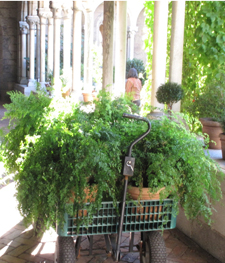
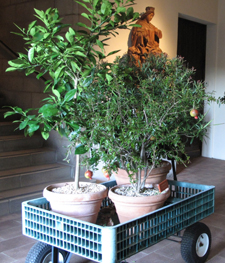
Potted plants too tender to spend the winter in Bonnefont garden are trucked inside and brought up to Cuxa cloister, which is??glazed in mid-October. Mediterranean plants such as bitter orange, myrtle, and bay laurel spend the cold season in the sunny arcades and??are brought back out to the herb garden when the glass comes down in mid-April. Left:??A wagonload of maidenhair fern in the arcade of Bonnefont garden. Right:??oranges and pomegranates en route to Cuxa cloister.?? Photographs by Carly Still
While the medieval plant collection at The Cloisters includes a good number of northern European species, a great many of the plants grown in the Bonnefont Cloister herb garden are Mediterranean in origin. Not all of these southern European plants are hardy for us here in New York City. The garden is a sheltered U.S.D.A. Hardiness Zone 7, and the fig tree (Ficus carica), poet’s jasmine (Jasminum officinale), and lavender (Lavandula angustifolia) do just fine outdoors, but more tender species like bitter orange (Citrus aurantium), rosemary (Rosmarinus officinalis), bay laurel (Laurus nobilis), and dittany of Crete (Origanum dictamnus) must be brought inside and protected from the cold. Read more »
Tags: Albertus Magnus, bay, Citrus aurantium, cucumber, cucurbit, dittany, fern, ficus carica, fig, jasmine, Jasminum officinale, laurel, Laurus nobilis, Lavandula angustifolia, Lavender, maidenhair, myrtle, orange, Origanum dictamnus, rosemary, Rosmarinus officinalis, santolina, winter
Posted in Food and Beverage Plants, Fragrant Plants, Gardening at The Cloisters, Introduction, Magical Plants, Medicinal Plants, Medieval Agriculture, Plants in Medieval Art | Comments (2)
Friday, October 21, 2011
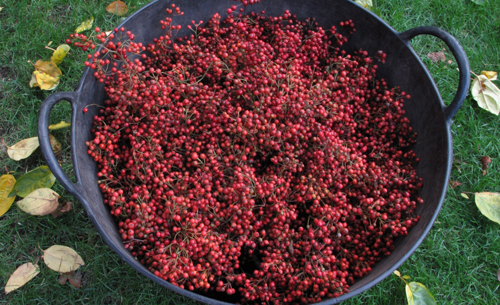
A tub of rose hips, gathered from roadsides and abandoned pastures upstate, and stripped of their thorns. The hips will be used to decorate the Museum this winter. Photograph by Carly Still
The rose hips used in the winter holiday decorations at The Cloisters allude to the rose symbolism prevalent in medieval Christmas carols. Although we grow medieval rose species in the gardens and on the grounds, their hips are too fleshy for our purposes, and don’t keep well.?? We gather stems of Rosa multiflora, which bear many small, hard, hips, in October, and strip them??of their thorns. They are stored in a cool, dry place until December, when the Museum is decked for the season.
Read more »
Tags: cattle, erosion, hips, Japanese rose, Rosa multiflora, rose, rose hip, weed
Posted in Food and Beverage Plants, Gardening at The Cloisters, Medicinal Plants, Useful Plants | Comments (1)
Wednesday, October 12, 2011
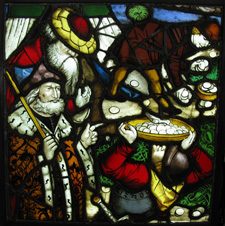
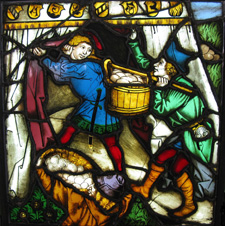
The marvelous food??depicted in these two panels of Late Gothic German stained glass may have been of vegetable origin. Left: Gathering Manna. Moses, holding the staff received from God on Mount Sinai, presides over the gathering of a miraculous fall of quail and manna from heaven. Right: Storing up Manna. Two men bear a large wooden tub of manna into a tent; a third man carries a great basketful in his arms.
The identification of Biblical plants has occupied investigators for centuries; the identity of manna is??one of??the most intriguing and most debated of ethnobotanical mysteries, although some interpreters have suggested that the substance is of insect rather than vegetable origin. Read more »
Tags: Albertus Magnus, algae, Avicenna, Bible, Circa Instans, Coccus manniparus, Exodus, Fraxinus ornus, Hortus Sanitatis, Lecanora esculenta, lichen, manna, Nostoc commune, Platearius, tamarisk, Tamarix mannifera
Posted in Food and Beverage Plants, Medicinal Plants, Plants in Medieval Art | Comments (1)
Friday, September 23, 2011
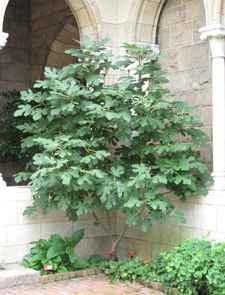

A young fig tree flourishing in a sheltered corner of Bonnefont garden; detail of the ripe fruit (click to see full image)???note the tiny hole in the base of the fig at the lower right, and the milky sap that exudes from the stems when the figs are picked.??This latex was a medicament and a rennet; it was also used as a mordant in medieval gilding and as a binder in the preparation of egg tempera.?? Photographs by Deirdre Larkin
So when the woman saw that the tree was good for food, and that it was a delight to the eyes, and that the tree was to be desired to make one wise, she took of its fruit and ate; and she also gave some to her husband, and he ate.
Then the eyes of both were opened, and they knew that they were naked; and they sewed fig leaves together and made themselves aprons.
???Genesis 3:6, 7
Much of the plant lore of the Middle Ages, like many other aspects of medieval culture, was a synthesis of classical and biblical tradition. The Tree of Knowledge is not named in the biblical account of the Fall; more than one species has been identified with the forbidden fruit, and the fig is among them. In Greco-Roman culture, the fig was associated with fertility and with the female genitalia. D. H. Lawrence??explores??this complex of cultural associations in his remarkable poem “Figs” (listen to a reading of this poem on YouTube).
Read more »
Tags: Adam, Alcinous, Athenaeus, Bugiardini, De Materia Medica, Deipnosophists, Dioscorides, Eisen, Eve, ficus carica, fig, forbidden, Genesis, Hildegard of Bingen, Pliny, Rumina
Posted in Food and Beverage Plants, Medicinal Plants | Comments (1)
Friday, July 8, 2011
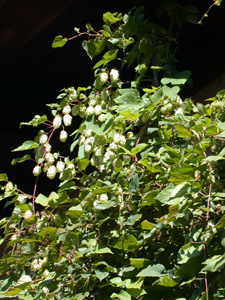
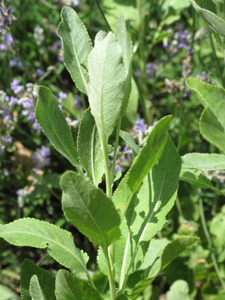
Hops (Humulus lupulus), considered today to be crucial to beer brewing, were not commonly used until the fifteenth century. Before that time, brewers added different herbs, such as??alecost??(Tanacetum balsamita), to their beer to improve its flavor. Several of these medieval brewing herbs can be found in Bonnefont garden.
Ale is made of malte and water; and they the which do put any other thynge to ale then is rehersed, except yest, barme, or godesgood, doth sofystical theyr ale.
???Andrew Borde, The fyrst boke of the introduction of knowledge, 1452
Beer was a staple drink for medieval Europeans, as it provided much-needed calories to the often undernourished population and was cleaner and safer to drink than water. Then, as now,??beer was made by brewing malted barley in boiling water to make sugars more available for yeasts to consume (see an image of Jorg Prewmaister tending his brew in a page from a fifteenth-century German manuscript, Amb. 317.2). This sugary, malty potion, known as “wort,” eventually becomes beer after the yeasts eat the sugars, releasing carbon dioxide and alcohol as byproducts of fermentation. On its own, wort is fairly flat in flavor, so brewers add additional ingredients, such as hops and spices, to enliven a beer’s taste.
Read more »
Tags: Achillea millefolium, Add new tag, ale, alecost, barley, beer, brew, bryan_stevenson, costmary, Glechoma hederacea, ground ivy, gruit, hops, humulus lupulus, Ledum palustre, malt, Myrica gale, Reinheitsgebot, stinging nettle, sweet gale, Tanacetum balsamita, Urtica dioica, wild rosemary, wort, yarrow
Posted in Botany for Gardeners, Food and Beverage Plants, Fragrant Plants, Medicinal Plants | Comments (3)
Thursday, April 28, 2011
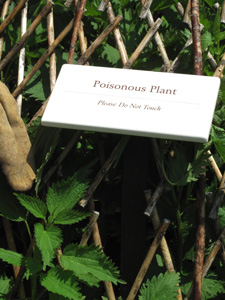
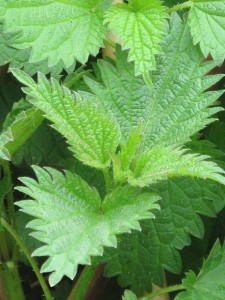
Leather gauntlets are required when handling the stinging nettles grown in Bonnefont garden. The nettles grow in the middle of a raised bed, where visitors won’t brush against them inadvertently, and are caged with willow and labeled as an additional safeguard (see full image). Photographs by Corey Eilhardt
But this little patch which lies facing east
In the small open courtyard before my door
Was full ??? of nettles! All over
My small piece of land they grew, their barbs
Tipped with a spear of tingling poison.
What should I do? So thick were the ranks
That grew from the tangle of roots below,
They were like the green hurdles a stableman skillfully
Weaves of pliant osiers when the horses hooves
Rot in the standing puddles and go soft as fungus.
So I put it off no longer. I set to with my mattock
And dug up the sluggish ground. From their embraces
I tore those nettles though they grew and grew again.
???From Hortulus by Walahfrid Strabo. Translated from the Latin by Raef Payne. The Hunt Botanical Library, 1966.
The stinging nettles in Walahfrid’s monastery garden were clearly unwanted, but Urtica dioica is carefully cultivated in Bonnefont Cloister garden. A common perennial weed of moist soil and disturbed ground, stinging nettle is widely distributed throughout Europe, Asia, and North America, having crossed the ocean with the earliest English settlers. (See the U.S.D.A. database for more information). Nettles thrive on the phosphates that are a product of human habitation and animal husbandry, and are often found near long-abandoned settlements and waste dumps. Read more »
Tags: Aesop, antihistamine, broad-leaved dock, flax, formic acid, Herbarius Latinus, Hildegard of Bingen, hydrocortisone, nettle, phosphate, Physica, Rumex obtusifolius, Urtica dioica
Posted in Food and Beverage Plants, Gardening at The Cloisters | Comments (1)
Friday, December 3, 2010
Above, from left to right: Saint Barbara (detail), mid-15th century, French, Gift of Mr. Edward G. Sparrow, 1950 (50.159); Detail of Saint Barbara from The Virgin Mary and Five Standing Saints above Predella Panels, 1440???46, The Cloisters Collection, 1937 (37.52.1); Saint Barbara (detail), ca. 1490, German, The Cloisters Collection, 1955 (55.166).
Although Saint Barbara is not mentioned in early martyrologies, hagiographies place the early Christian virgin and martyr in the third century A.D. According to The Golden Legend, a popular collection of saints’ lives dating to the thirteenth century, she was martyred on the fifth of December, during the reign of Emperor Maximianus and under the orders of Martianus, the prefect of her city of Heliopolis, in??Phoenicia. Veneration of Saint Barbara was common in both the eastern and western churches by the ninth century, and she remains a popular saint to this day, although her feast is widely celebrated on the fourth rather than the fifth of December. Read more »
Tags: Adonis, anise, Anthesteria, Barbarazweig, Barbarea, Barbarea vulgaris, barley, Eleusinian Mysteries, kykeon, Martianus, Maximianus, pomegranate, Provence, raisin, Saint Barbara, The Golden Legend, wheat, winter cress, yellow rocket
Posted in Food and Beverage Plants, The Medieval Calendar | Comments (4)
Wednesday, November 17, 2010
The pretty, fragrant lesser calamint flourishes in all three of the enclosed gardens at The Cloisters. Each small shrub bears a host of delicate little flowers from late summer through frost. Above, from left to right: The lipped flowers of calamint are characteristic of members of the Labiatae, or mint, family; cold weather brings out the purplish cast in the flowers; calamint is beautiful even in winter, when the fine stems are bare.
The larger-flowered calamint, known as Calamintha grandiflora, is frequently grown in modern gardens, but the lesser calamint, Calamintha nepeta, is the calamint of the Middle Ages. Read more »
Tags: calamint, Calamintha grandiflora, Calamintha nepeta, Calamintha officinalis, Cuxa Garden, marjoram, nepitella, Satureja hortensis, Satureja montana, savory, White Cloud
Posted in Food and Beverage Plants, Gardening at The Cloisters, Medicinal Plants | Comments (1)
Friday, October 29, 2010
The edible weeds that grew among the cultivated vegetables in the medieval kitchen garden were also harvested and used as potherbs. Above, from left to right: purslane, a succulent weed of fertile soils, is a common weed in our own vegetable gardens; lamb’s quarters, also known as “fat hen,” is now a very common weed in the United States; Good King Henry is related to the nutritious lamb’s quarters and was cultivated as a vegetable. Photographs by Corey Eilhardt.
A weed is a plant you don’t want. An herb is a plant with a use. But many of the “weedy” species that are considered garden nuisances today were actually valued in the Middle Ages. Edible weeds growing in the kitchen garden, along with the cultivated vegetables, were used in pottage, a basic medieval dish. (For more on pottage, see last week’s post, “Colewort and Kale.”) Read more »
Tags: cabbage, Chenopodium album, Chenopodium bonus-henricus, dandelion, Good King Henry, herb, kale, lamb's quarters, leek, Portulaca oleracea, pottage, purslane, ribwort plantain, weed
Posted in Food and Beverage Plants, Gardening at The Cloisters, Medicinal Plants | Comments (4)













